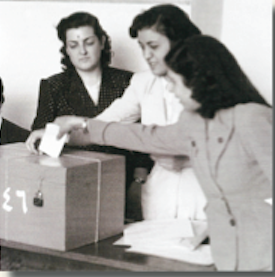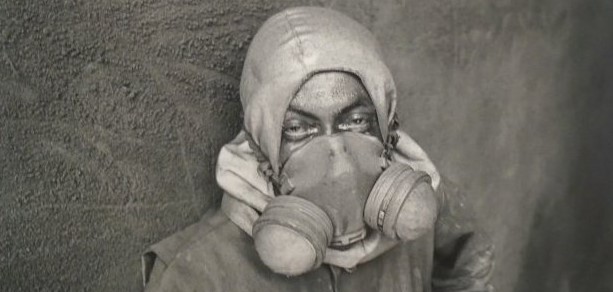Lebanese Women and the Right to Vote

This article is written by Dr. Akram Khater, Director of the Khayrallah Center for Lebanese Diaspora Studies and a Professor of Middle East Studies at North Carolina State University.
The focus of this articles comes from his book, Inventing Home: Emigration, Gender and the Middle Class in Lebanon, 1870-1920 In 1953, Lebanese women voted for the first time in the history of the Republic and obtained the right to run for election. This was the victorious culmination of the decades long efforts of the Lebanese women’s movement to gain equal rights. In many ways the story begins in the United States among Lebanese immigrants. From the earliest days of Lebanese immigration, women were ever-present, and their share grew steadily over time. Thus, between 1878 and 1909, women made up 38.6% of immigrants to Mexico and Brazil. Similarly in Australia, between 1911 and 1947, women regularly made up 48% of the immigrating population from Lebanon. In the United States, during the peak years of “Syrian” immigration between 1899 and 1914, women constituted 32% of the immigrants. Many came as wives, daughters, and sisters to reunite with their relatives. Others-like Gibran Khalil Gibran’s mother-left an abusive husband back in Bsherri [Bsharri], or were widowed and left without any support. Still others came seeking to make money and support their families back in Lebanon. Regardless of their reasons for coming, once here it became abundantly clear that the traditional norms of village life would no longer hold. Women had to work outside the house as frequently as men either by necessity or choice. For example, Budelia Malooley recounted how
“Mother arrived and started to peddle in Spring Valley [Illinois]…must have been in her mid-teens at the time. She resumed peddling on her return to Spring Valley from Lebanon after my father died and I was born [about the first part of 1904]. She’d make $5 to $10 / week. She’d have to send money back to Rachaya to support my sister and brother.”
Women’s work in factories or peddling on the road brought them a sense of empowerment and opened up debates within the Lebanese-American community about gender roles. Writing in 1903, Yusuf al-Za’ini, proclaimed women’s work as “a disease whose microbes have infested healthy and sick bodies alike,” and which leads women to “lewd, filthy and wanton behavior.” Another author, Elias Nasif, contended that “woman was created for the house and the man for work, and it is shameful for the man and woman to exchange their jobs.” On the other side of the argument were writers like Afifa Karam who argued that women’s work brought them honor. Other authors, like Mariam al-Zammar, contended that women should be equal to men in every regard be it education, work, or decision making within the family. These debates paralleled, and augmented, similar debates taking place in Lebanon. Newspapers and magazines there had taken up the “women’s issue” since the early 20th century with various thinkers and politicians taking opposite positions on the matter. For instance, in 1895 Salma Kalia wrote in the newspaper Lebanon that:
“A woman is not lower in rank [than a man]. This is particularly obvious after science and enlightenment has uncovered the true and natural position of a woman, her capacities and mental prowess and her ability to [do] all that a man practices.”
Others held a differing position. In 1909, Anisa al-Shartouni penned pamphlets that concluded “…according to her constitution [a woman] must stay in her house to take care of its affairs.” As the debates raged in Lebanon and amongst immigrants in the mahjar [land of immigration], we begin to see cross-fertilization of ideas and positions. Thus, Afifa Karam wrote many essays to her “Eastern sisters” that were published in Lebanon (and Egypt) advocating equal rights for women on all fronts.

Some authors in Lebanon pointed to the rising status of immigrant Lebanese women in terms of education and work as indication that any fetters on their upward mobility in Lebanon should be removed. These arguments came to a head during a debate that took place at the Syrian Parliament convened in 1920 to chart the constitution of the newly independent and short-lived state. Meeting in Beirut, the Parliament was made up of all-male delegates from Lebanon, Syrian and Palestine. One of the most contentious topics debated was suffrage for women. A majority of the delegates opposed giving women voting and election rights, dismissing the idea with remarks such as “God has made her with half a brain.” Others feared the “rabble” would rise in protest if such a law passed. A minority of those attending the conference braved the derision of their fellow delegates to proclaim that “an educated woman is better than a thousand ignorant men, so why should we give men the right to vote and yet deprive educated women from that right?” Ultimately, the bill was not approved and women had to wait another 30 years to obtain their right to vote and run for elections. In the interim, the feminist movement-which began amongst women in the mahjar and back in Lebanon-continued to grow stronger. Between WWI and WWII, when Lebanon was under the colonial control of France, women like Julia Dimashqiyya and Nazira Zayn al-Din continued to fight for their rights. Dimashqiyya, who served the first female headmistress of the Maqasid school in Beirut, gave impassioned speeches and wrote eloquent editorials tying the fortunes of Lebanon and Syria to giving women more rights. She argued that the nation could not rise with half of its population paralyzed by outdated laws and mores.

In 1928 Nazira Zayn al-Din-a young woman in her mid-twenties-unleashed a political storm when she published a book titled al-Hijhab wal-Sufur [Veiling and Unveiling] in which she used religious arguments to advocate unveiling, education and full participation for women. While she was promptly attacked by the religious establishment, the debate she unleashed was instrumental in moving the cause of women’s rights forward, and garnered support for her position even among some religious scholars. Despite all their efforts, these women would not see the fruits of their labor until a decade after 1943. Preoccupation with the struggle with France for independence, as well as other matters were used as excuses to keep the issue on the back-burner. Finally, in 1952 the law passed that gave women the suffrage, and in 1953 women cast their first votes. While that right was gained by women over 50 years ago, they are still fighting today against the predominantly patriarchal political system to gain more seats in the parliament and a larger voice in the country.
- Categories:


